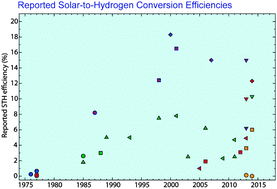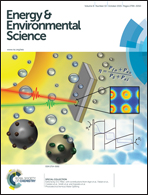Experimental demonstrations of spontaneous, solar-driven photoelectrochemical water splitting†
Abstract
Laboratory demonstrations of spontaneous photoelectrochemical (PEC) solar water splitting cells are reviewed. Reported solar-to-hydrogen (STH) conversion efficiencies range from <1% to 18%. The demonstrations are categorized by the number of photovoltaic junctions employed (2 or 3), photovoltaic junction type (solid–solid or solid–liquid) and the ability of the systems to produce separated reaction product streams. Demonstrations employing two photovoltaic (PV) junctions have the highest reported efficiencies of 12.4% and 18%, which are for cells that, respectively, do and do not contain a semiconductor–liquid junction. These devices used PV components based on III–V semiconductors; recently, a number of demonstrations with >10% STH efficiency using potentially less costly materials have been reported. Device stability is a major challenge for the field, as evidenced by lifetimes of less than 24 hours in all but a few reports. No globally accepted protocol for evaluating and certifying STH efficiencies and lifetimes exists. It is our recommendation that a protocol similar to that used by the photovoltaic community be adopted so that future demonstrations of solar PEC water splitting can be compared on equal grounds.

- This article is part of the themed collection: Status of Photoelectrochemical Water Splitting: Past, Present, and Future

 Please wait while we load your content...
Please wait while we load your content...